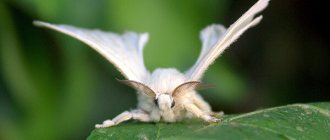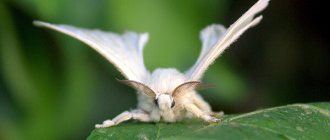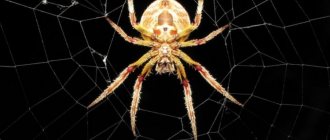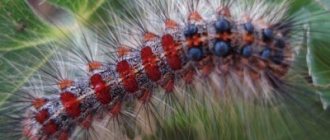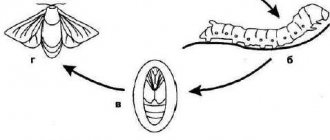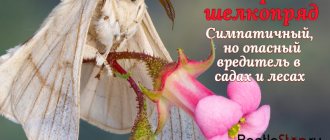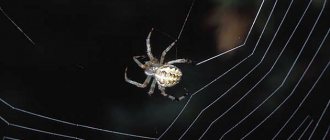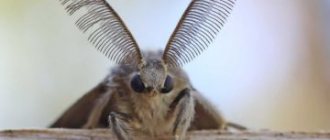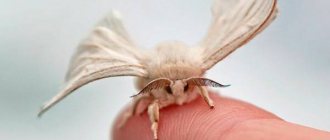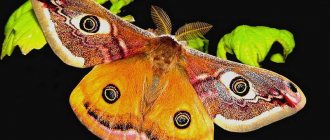Description
The silkworm represents the family of True silkworms and the order Mulberry. The name also reflects its permanent habitat – mulberry trees. Since the silkworm butterfly is voracious, it spends most of its life in trees.
The life cycle consists of several stages:
- Egg.
- Caterpillar.
- Doll.
- And the silkworm butterfly.
The life of free insects differs from the life of the “domestic” species. This usually does not survive to the last stage, if we are talking about mass rearing of silkworms to obtain silk thread. It is at the pupal stage that the life cycle of insects is interrupted by high temperatures. This allows you to maintain the integrity of the cocoon. Transformation into a butterfly does not occur.
Cocoons consist of an unbroken thin silk thread. They are woven in different sizes - from 1 to 6 cm, and in various shapes: round, oval, with jumpers. The thread also comes in different shades, but it is valued by fabric manufacturers in pure white.
In nature, the larva hatched from an egg is extremely small - a few millimeters. Its size increases very quickly, because... Eating of leaves occurs around the clock. In just the next few days, the worm undergoes 4 molts, due to which it acquires a beautiful pearl color. The adult silkworm caterpillar has a body length of approximately 8 cm and a thickness of 1 cm. The weight is equal to 3-5 grams.
The main value of the silkworm is its ability to produce silk thread. This is accomplished due to the presence of special glands with an opening in the oral cavity. From here a liquid is released, which hardens in the air and is formed into a thread by the insect.
Silkworm death producing silk
Natural silk is a wonderful fabric that has no analogues; its history is steeped in ancient legends, and the production process has changed little over several millennia.
When I conceived the article, I wanted to write about everything at once - history and legends, production, types of fabrics, their wonderful properties. As it turned out in reality, there is too much interesting material, and it is a pity to cut it into pieces so as not to bore the reader. Let there be a cycle that is more detailed and interesting!
In this article I will describe the process of producing raw silk.
The publication will also be of interest to fans of felting , because... Tussa and Mulberry silk, as well as silk scarves, tows, cocoons and other materials are widely used in wet felting.
So, where does silk come from, and why does the article have such a gloomy title?
Natural mulberry silk ( Mulberry).
Probably, almost everyone knows that we are provided with natural silk by amazing worms - unsightly-looking caterpillars (larvae) of the silkworm. High-quality silk is produced by these worms, and is often called “mulberry silk” or Mulberry silk (Mulberry is a mulberry tree translated from English), we call the mulberry tree mulberry and many people love its fruits. And the larvae love leaves and turn them into silk thread. The silkworm (scientific name Bombyx mori - Latin ) is a butterfly from the family True silkworms, translated from Latin Bombyx mori means “death of the silkworm” or “dead silk”. The name comes from the fact that the butterfly is not allowed to fly out of the cocoon, it dies inside.
The butterfly is very impressive; it has also been called “silk moth”: The wingspan is 4-6 cm, the caterpillar can grow up to 9 cm before pupation.
It is believed that the Bombyx mori butterfly originated from a wild silk butterfly that lives on the mulberry trees of China. This was a very long time ago, it is believed that the history of silk production goes back at least 5,000 years, and over a long period of breeding butterflies in captivity, they lost the ability to fly well. Females practically do not fly, males fly a little during the mating period, so to speak, in moments of elation.
Process of obtaining raw mulberry silk
The butterfly, having hatched from the cocoon, mates with the male, and then begins to lay eggs. In 4-6 days she lays up to 800 eggs, does not eat anything, because... its oral apparatus is underdeveloped, and after finishing its work, it dies. Eggs are checked, selecting healthy ones that are not affected by infection. In this way, the quality of future silk and the reproduction of healthy butterflies are controlled.
Each egg after a week gives rise to a larva of about 2-3mm with an unimaginable appetite. The larva must be fed regularly day and night for a month with mulberry (mulberry) leaves. The leaves are collected, sorted by hand and crushed. All this time, the larvae are kept in large trays with leaves, placed one on top of the other in a special room with constant temperature and humidity. The larvae are surprisingly sensitive - there should be no drafts, foreign odors or loud sounds in the room. What can happen if the conditions are not met? it’s just that the caterpillar will not spin a cocoon, it will die, and all the efforts of the silkworm breeders will be in vain.
The caterpillars' appetite is constantly growing, and within a day they eat twice as much as the previous day.
The constant work of the huge number of silkworms' jaws in the room produces a roar similar to the drumming of heavy rain on the roof.
On the fifth day of life, the larva freezes and sleeps for a day, tightly grasping the leaf. Then it straightens up sharply, and the old tight skin bursts, releasing the grown caterpillar. During the feeding period, the larvae change their skin 4 times and return to eating.
Before pupation, the caterpillars lose interest in food and begin to behave restlessly, constantly shaking their heads back and forth. Under the lower lip there are glands that produce silk substance. At this point, they represent 2/5 of the body weight, and are so full that a silk thread trails behind the caterpillar.
Sericulture breeders move the caterpillars onto floorings of leaves and branches, onto wooden grates or special bundles of rods for spinning a cocoon.
First, the caterpillar is attached to a twig or other base, creating a fluffy mesh frame, and only then it spins a cocoon inside it. It begins to secrete a gelatinous substance, which hardens in the air, forming a silk thread, and with rotational movements it wraps itself around this thread in the shape of a figure eight.
The thread consists of 75-90% protein - fibroin and the adhesive substance sericin, which holds the threads together and prevents them from falling apart; the thread also contains salts, fats and wax. The caterpillar completes the cocoon in 3-4 days.
An interesting fact: the cocoons of males are made more carefully - they are denser and the length of the thread is longer than those of females. Those who have ever held cocoons in their hands know how pleasant and silky they are to the touch.
After 8-9 days, the cocoon is ready to unwind. If you miss the time, after 2 weeks the butterfly will emerge from the cocoon, damaging the silk shell. Because The butterfly's mouthparts are undeveloped; it does not gnaw through the cocoon, but secretes a special caustic substance that dissolves the upper part of the cocoon. Such a cocoon can no longer be unwound; the thread will be torn.
Therefore, the pupa is killed by heating the cocoons with hot air, and it suffocates in the cocoon, which is where the name “death of the silkworm” or “dead silk” comes from.
Here it is, a wonderful raw material for silk!
The cocoons are sorted by size and color and prepared for unwinding.
Wash alternately in hot and cold water. The adhesive substance sericin, which holds the threads together, dissolves enough to allow the thread to be unwound.
According to all sources studied, only the unwinding of thread is mechanized at present; all previous stages of production remain completely manual labor, as in ancient times.
The thread of one cocoon is very thin, so when unwinding, from 3 to 10 threads are connected, thus obtaining raw silk. When one of the threads ends during the winding process, a new one is screwed onto it, ensuring continuity. The sericin (sticky substance) remaining in the thread helps to easily hold the ends of the thread together.
Raw silk requires further processing; it is wound into yarn and sent to a weaving factory. Factories buy silk by weight, but during further processing such raw silk loses 25% of its weight - it is soaked to remove residual sericin and bleached. To compensate for their losses, factories enrich silk with metal salts or water-soluble substances - starch, sugar, glue or gelatin. Such impregnations make it possible to weave threads more economically and compensate for weight loss during weaving.
The sources don’t say it directly, but I think that’s why natural silk shrinks quite a bit when washed. After all, if you wash salts or water-soluble impregnations from the fabric, the fabric will shrink the freed space.
After unwinding the cocoons, a dead pupa remains, which is rich in protein and can be eaten!
Nowadays, the silkworm culture is bred exclusively artificially. The cocoons that the silkworm caterpillar weaves can be of various shades from white to yellow and even grayish. The white variety of cocoons contains the highest percentage of silk protein and produces the best quality silk. Produced by silkworms in Japan, China and India. Japan was the first to apply a scientific approach to the selection and breeding of silkworms in special laboratories, and now surpasses other countries in the efficiency of silk production, but China is the leader in production volumes.
It is believed that France and Italy make silk fabric of higher quality than Asian countries. But the raw material, raw silk, is purchased by European manufacturers in China.
Fabric white Chinese silk:
I came across this example: a woman’s blouse requires a thread from 600 silkworm cocoons.
Traditional Thai mulberry silk is obtained by processing the yellow cocoons produced by another variety of silkworm, Bombix Mori. The breeding process is similar.
Yellow cocoons contain less silk protein, and the thread is uneven - it has thickenings. When twisted, the thread turns out to be uneven, and on Thai-made silk we see such characteristic thread thickenings. Again, the entire production process is manual labor, often even unwinding is done by hand, so Thai silk is quite expensive and in Thailand is only available to wealthy Thais.
Thai silk fabric:
Natural “wild silk”, “tussah silk (Tussah, tussar)” What is it and how does it differ from mulberry silk?
This silk is “wild” because the butterfly is grown in natural conditions, on bushes and trees, which are at most protected by canopies. Sericulture breeders only look after the caterpillars and protect them from birds. Silk cocoons are collected after the butterfly has left the cocoon, and the butterflies are completely different - Antheraea, a species of nocturnal peacock moth , which is called the oak silkworm . The butterflies are large, fly well, and the caterpillars grow up to 10cm before pupation.
Chinese oak silkworm (there are Japanese, Mongolian and other varieties). The wingspan of the butterfly is 10-15 cm.
They can feed on oak, apple, plum or chestnut leaves, and their cocoons are distinguished by a brownish color and a coarser and stronger thread. The cocoons are large, several times larger than mulberries, and can reach the size of a small chicken egg.
Some sources write that the thread is difficult to unwind, and the silk fiber is combed from the cocoon, while others say that the thread unwinds perfectly. I don't know where the truth is!
Also, wild silk has less shine; its thread does not shine evenly, but seems to sparkle.
Silk obtained in this way is not bleached to a pure white color. The fabric is durable and is often used for interior decoration and the production of very durable, dense silk suiting fabrics.
Personally, I’ve been itching to paint it for a long time, it will be a gorgeous skirt, but I still don’t have time.
Dyed wild silk fabric:
I hope, dear readers, that the article was interesting to you. Personally, in the process of writing, I learned a lot of new things for myself and understood, having appreciated the scale of manual labor, why real natural silk cannot be cheap 
The photos in the publication are most likely small private farms in Asia. In China, it is very common for farmers to raise silkworms and then sell the cocoons by weight for further processing.
The article was written using materials from various Internet sites.
Kinds
The family includes approximately two hundred species. But the most studied is the silkworm. This is explained by its value for modern humanity. Other types are not considered beneficial. They are pests as they destroy fruit trees and wild plants.
Ringed
This cocoon moth is one of the most famous. In appearance, it has the following features: a yellowish-brown body color and a wingspan of up to 4 cm. At the emerging stage, the small caterpillars are almost black. As they mature, they acquire bluish-gray shades. Their total length reaches approximately 5.5 cm.
The name of the species is explained by the fact that females lay eggs in a ring around plant branches. There are up to 300 eggs in a clutch. Hatched caterpillars cause great damage to garden trees (pear, apple, plum). If food becomes scarce, they migrate to nearby oaks, poplars, birches, linden, and small bushes.
Nun
This insect is classified as a silkworm, but in fact the species is part of the Volfyanka family. It is distinguished by its nocturnal lifestyle. The wingspan reaches 5.5 cm. This silkworm moth has a light gray color, decorated with dark zigzags. The caterpillars have a gray body with a dark head. Insects are very harmful to forestry plants. It eats needles on mature trees and young shoots of needles (like the Siberian silkworm). They also affect oak, birch, beech and apple leaves.
Unpaired
The name "unpaired" comes from the fact that the male and female will look different as adults. The weaver is large, yellow in color and with a wingspan of up to 9 cm. The weaver is darker with a brown tint, but has a smaller wingspan - up to 4 cm. Their caterpillars eat many species of plants (there are from 250 to 300 of them). These include fruit crops and valuable wood species. Therefore, the presence of this representative of the family is extremely undesirable.
Useful properties of silk thread
Silkworm saliva contains sericin, a substance that protects silk from pests such as moths and mites. The caterpillar secretes matting substances of sheer origin (silk glue) from which it weaves a silk thread. Despite the fact that most of this substance is lost during the production of silk fabric, even the little that remains in the silk fibers can protect the fabric from the appearance of dust mites.
Thanks to serecin, silk has hypoallergenic properties. Due to its elasticity and incredible strength, silk thread is used in surgery for suturing. Silk is used in aviation; parachutes and balloon shells are sewn from silk fabric.
The benefits and harms of silkworms
Man was able to tame the silkworm for his own benefit. The fabric made from its silk threads is highly valued in the market. Other types of silkworms are considered pests. Thanks to the natural food chain in nature, the number of silkworms is controlled. They have natural enemies, so outbreaks of the pest are leveled out.
Thanks to the scientific research of biologists, the breeding of desirable breeds of insects, taking into account the genotype, has long begun. This made it possible to achieve a greater length of silk thread. But in general, it gave great progress for the formation and development of the sericulture industry.
Silk cocoon can become a natural remedy for peeling and massaging the skin. In Asian countries, consumers are offered yellow cocoons for this purpose. This color is called gold for marketing purposes.
Silkworm food for gourmets
Few people know about the nutritional properties of the mulberry caterpillar. This is an ideal protein product and is widely used in Asian cuisine. In China, maggots are steamed and grilled, seasoned with a huge amount of spices, and you won’t even understand what is “on the plate.”
In Korea, half-raw silkworms are eaten and lightly fried. This is a good source of protein.
Dried caterpillars are commonly used in Chinese and Tibetan folk medicine. The most interesting thing is that mold fungi are added to the “medicine”.
Appearance and features
According to the description, the appearance of the insect is nondescript, but at the same time somewhat repulsive, which can be seen in the photo. This is not a “slender” butterfly with colorful wings. Rather, in appearance it resembles a faded massive moth. The body is short with a thick body and legs. It is covered with a thick layer of short pile. The size of the wings varies somewhat, but in a state of rest in all individuals, the hind wings are hidden under the forewings.
The wings are quite large. This suggests that initially the insect was more mobile and could fly well. So they moved over considerable distances. But after active domestication, butterflies eventually weaned themselves from flying. Now females do not fly at all, and males are able to make short flights for the purpose of mating.
What do silkworms look like? Appearance Features:
- the color is dominated by light shades with fuzzy spots;
- there are dark brown bandages on the wings;
- there is a notch in the front area of the wings;
- The antennae are comb-shaped, which distinguishes the silkworm from many other insects.
Adult mulberry moths have underdeveloped mouthparts. They live off the reserves accumulated during the larval stage. Caterpillars differ in this regard in the structure of their mouth. They are extremely gluttonous.
Silkworm - interesting facts
- The silkworm received the name “mulberry” because its caterpillars eat mulberry leaves.
- The life cycle of a silkworm: the butterfly lays eggs, the larva develops, the caterpillar, after 12 days in the cocoon the insect turns into a butterfly.
- Man has domesticated this insect, it is completely dependent on us: the caterpillar does not get its own food, the butterfly has lost the ability to fly (there is no need) and feed on its own.
- Silk thread is obtained from the cocoon of the silkworm - it is simply twisted, and the cocoon itself is used for cosmetic purposes (creams and lotions).
- One insect cocoon produces up to 1000 meters of silk thread.
- In Central and South Asia there are factories for raising silkworms and making silk thread.
- The cocoons of these caterpillars are used not only for the production of fabrics, but also in cosmetology as a means of cleansing the skin. And in Asian cuisine, the caterpillars themselves are considered a delicacy and are eaten.
- 32 layers of silk are capable of holding a pistol bullet. Therefore, silk thread is used in the production of body armor.
- The nature of a silk thread is similar to a spider's web. Silk thread is a mixture of proteins and saliva of the mulberry caterpillar, from which they make their cocoons. The thread, like the web, is very strong. For example, a silk cable will be stronger than a metal cable of the same thickness.
- At one time, in Tsarist Russia, soldiers were given silk underwear in the army, in which parasites could not live.
- In ancient times, silk was worth its weight in gold.
- Silk thread is very durable and can withstand great pressure. Silk ropes are more efficient in operation than hummocks made of steel of the same thickness.
Few people know that the gypsy moth, which is a major pest of the US forestry industry, was spread as a result of a failed experiment. As they say, I wanted the best, but what happened was the following.
At the end of the nineteenth century, one person came up with the idea to breed a new species; he planned to cross the silkworm and the gypsy moth. To get an insect that is less “picky in food”, but at the same time it must produce silk thread. For this purpose, a batch of gypsy moth cocoons was brought from Europe to America. The experiment ended in complete failure. The scientist was unable to cross these types of silkworms, but the gypsy moth has “comfortably” settled down in America and is now causing harm to the forestry of the United States of America.
Video
Where does it live?
For a comfortable life and active production of thread, the silkworm needs specific climatic conditions. Without them, insects are not able to perform their main function - the formation of cocoons and pupation. In this regard, the insect lives in areas with a warm and moderately humid climate, where there are no serious temperature changes. The vegetation should be rich, in particular many mulberry trees.
Today, the habitat is determined by the active work of mulberry production. For this purpose, insects were brought to many regions with a suitable climate in order to breed them artificially. It is China and India that have the status of the main countries for the residence of “useful” silkworms. 60% of the silk produced worldwide is produced here. Silkworms are also actively raised in Korea, Japan, Brazil, Russia, and some European countries.
What does it eat?
What does an insect like to eat? The name "silkworm" clearly reflects its preference - it is the foliage of the mulberry tree. Otherwise it is called mulberry. There are 17 species of this tree and all of them are suitable for feeding insects. The trees grow juicy berries of red and black color with a fragrant aroma, which become objects for eating by birds and other insects: beetles, wasps, etc. But the silkworm caterpillars are interested in foliage. The shoots and tree bark remain untouched by them.
Interesting! Silkworm larvae eat leaves continuously. Near a tree, you can even hear the characteristic sound of eating leaves, because there are a lot of caterpillars here at the same time.
In the natural environment, silkworms also eat other plants. But this is only possible if there is a lack of food. Because of this, the quality of the silk thread decreases.
Nutrition
Caterpillars must eat almost continuously. They feed on mulberry leaves, eating them at an incredible speed.
The caterpillar, born from an egg, has a length of 0.3 cm and weighs 0.0004 g, and after some time its length is up to 8.5 cm and its weight is 3.5 g. Sometimes caterpillars also eat the leaves of other plants . However, observations have shown that caterpillars fed with mixed food grow much more slowly, and the quality of the silk fiber they produce changes - the thread becomes thicker than that of caterpillars fed only mulberry leaves. The caterpillars grow for up to 6 weeks, then they stop eating and spin a cocoon, inside which they turn into an imago (adult).
Features of character and lifestyle
Initially, silkworms are classified as pests. Only in mulberry production does his gluttony bring the desired results - an increase in production volumes. For forestry and garden plantings, the moth becomes truly dangerous.
The life cycle, consisting of four stages, lasts several months in nature. The living habits and appearance of caterpillars and butterflies are very different. Caterpillars constantly eat to constantly gain weight and create a reserve for the future. They have to be extremely active, moving from one leaf to another and never stopping working with their mouth. Butterflies, in contrast, are inactive. They don't need to find their own food, because... they use the reserves of nutrients that accumulated during the caterpillar stage. Their main task is reproduction. Egg laying lasts several days. Because butterflies are sedentary and interesting to study, they are easily captured by collectors.
Additional Information! Males use more energy to spin threads. The thread becomes longer and is more valuable. The shell of its cocoons turns out to be more dense and heavy. Therefore, males are preferable for breeding.
Due to domestication, insects lose their natural abilities: to fly, to find food. The prerequisites for flying and searching for food disappear. Domesticated specimens live in confined spaces with constant human care and provision of food.
Social structure and reproduction
In the question of reproduction, this is a paired insect. Some species lay eggs once a year, while others lay eggs twice. Only a few are distinguished by more frequent reproduction. Since during the mating period males increase their activity and can make short flights, they are able to fertilize several females at once. There are several hundred eggs in a silkworm's clutch. The figure can vary from 300 to 800 units. The exact number, as well as the size of the eggs, depends on the species.
For the larvae to hatch from eggs, a suitable temperature is required - about 23-25 degrees, as well as moderate air humidity. In production, such conditions and the mixing of males with females are controlled by humans.
Life cycle
After mating, the female lays an average of 500 to 700 eggs in a dense shell, the so-called grain. After this, the female dies. The eggs develop for about a week, then small larvae called “mulberry worms” hatch from them. The caterpillar grows rapidly, molting 4 times over the course of a month before reaching the final phase of its development.
Before pupation, the larva weaves a cocoon from a continuous silk thread, inside which it turns into a pupa. Butterflies emerge from cocoons 15-18 days after pupation. But in industrial sericulture, the imago is usually not expected to emerge; the cocoons are kept for 2-2.5 hours at a temperature of about 100 °C, killing the pupa, then the cocoons are untwisted to obtain a thread.
Natural enemies
In nature, the enemies of the silkworm are:
- birds (the sparrowhawk especially likes the silkworm);
- insectivores that eat larvae and butterflies (for example, they are a treat for squirrels);
- parasitic insects (for example, these are hedgehog flies or tahini, which lay eggs in the body of the silkworm);
- pathogens (eg pebrina).
Sericulture involves human struggle with the deadly enemies of the silkworm.
Population
Insects are very prolific in nature and are actively bred in artificial conditions. In both cases, they require similar living conditions. Therefore, independent spread of populations and their importation are allowed only in warm countries. One of the main conditions, in addition to acceptable temperature and air humidity, is the presence of mulberry trees.
Since the silkworm brings many benefits to humanity, its breeding will never stop. Thus, silkworm populations are not at risk of extinction in the natural environment or destruction by humans.
